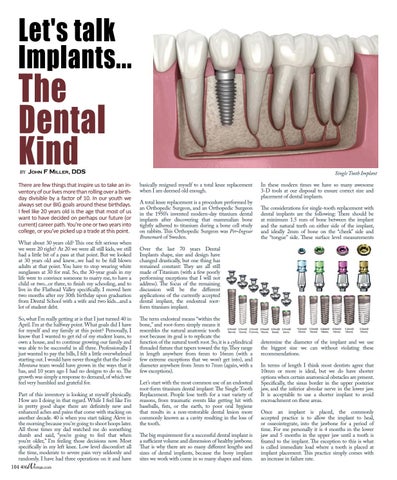Let's talk Implants...
The Dental Kind by John F Miller, DDS
There are few things that inspire us to take an inventory of our lives more than rolling over a birthday divisible by a factor of 10. In our youth we always set our BIG goals around these birthdays. I feel like 20 years old is the age that most of us want to have decided on perhaps our future (or current) career path. You’re one or two years into college, or you’ve picked up a trade at this point. What about 30 years old? This one felt serious when we were 20 right? At 20 we were all still kids, we still had a little bit of a pass at that point. But we looked at 30 years old and knew...we had to be full blown adults at that point. You have to stop wearing white sunglasses at 30 for real. So, the 30-year goals in my life were to convince someone to marry me, to have a child or two...or three, to finish my schooling, and to live in the Flathead Valley specifically. I moved here two months after my 30th birthday upon graduation from Dental School with a wife and two kids...and a lot of student debt. So, what I’m really getting at is that I just turned 40 in April. I’m at the halfway point. What goals did I have for myself and my family at this point? Personally, I know that I wanted to get rid of my student loans, to own a house, and to continue growing our family and was able to be successful in all three. Professionally I just wanted to pay the bills, I felt a little overwhelmed starting out. I would have never thought that the Smile Montana team would have grown in the ways that it has, and 10 years ago I had no designs to do so. The growth was simply a response to demand, of which we feel very humbled and grateful for. Part of this inventory is looking at myself physically. How am I doing in that regard. While I feel like I’m in pretty good shape there are definitely new and enhanced aches and pains that come with stacking on another decade. 40 is when you start taking Aleve in the morning because you're going to shoot hoops later. All those times my dad watched me do something dumb and said, “you’re going to feel that when you’re older,” I’m feeling those decisions now. Most specifically in my left knee. Low level discomfort all the time, moderate to severe pain very seldomly and randomly. I have had three operations on it and have
w
104 406
oman.com
Single Tooth Implant basically resigned myself to a total knee replacement when I am deemed old enough. A total knee replacement is a procedure performed by an Orthopedic Surgeon, and an Orthopedic Surgeon in the 1950’s invented modern-day titanium dental implants after discovering that mammalian bone tightly adhered to titanium during a bone cell study on rabbits. This Orthopedic Surgeon was Per-Ingvar Branemark of Sweden.
In these modern times we have so many awesome 3-D tools at our disposal to ensure correct size and placement of dental implants. The considerations for single-tooth replacement with dental implants are the following: There should be at minimum 1.5 mm of bone between the implant and the natural teeth on either side of the implant, and ideally 2mm of bone on the “cheek” side and the “tongue” side. These surface level measurements
Over the last 70 years Dental Implants shape, size and design have changed drastically, but one thing has remained constant: They are all still made of Titanium (with a few poorly performing exceptions that I will not address). The focus of the remaining discussion will be the different applications of the currently accepted dental implant, the endosteal rootform titanium implant. The term endosteal means “within the bone,” and root-form simply means it resembles the natural anatomic tooth root because its goal is to replicate the function of the natural tooth root. So, it is a cylindrical threaded fixture that tapers toward the tip. They range in length anywhere from 6mm to 16mm (with a few extreme exceptions that we won’t get into), and diameter anywhere from 3mm to 7mm (again, with a few exceptions). Let’s start with the most common use of an endosteal root-form titanium dental implant: The Single Tooth Replacement. People lose teeth for a vast variety of reasons, from traumatic events like getting hit with baseballs, fists, or the earth, to poor oral hygiene that results in a non-restorable dental lesion more commonly known as a cavity resulting in the loss of the tooth. The big requirement for a successful dental implant is a sufficient volume and dimension of healthy jawbone. That is why there are so many different lengths and sizes of dental implants, because the bony implant sites we work with come in so many shapes and sizes.
determine the diameter of the implant and we use the biggest size we can without violating these recommendations. In terms of length I think most dentists agree that 10mm or more is ideal, but we do have shorter options when certain anatomical obstacles are present. Specifically, the sinus border in the upper posterior jaw, and the inferior alveolar nerve in the lower jaw. It is acceptable to use a shorter implant to avoid encroachment on these areas. Once an implant is placed, the commonly accepted practice is to allow the implant to heal, or osseointegrate, into the jawbone for a period of time. For me personally it is 4 months in the lower jaw and 5 months in the upper jaw until a tooth is fixated to the implant. The exception to this is what is called immediate load where a tooth is placed at implant placement. This practice simply comes with an increase in failure rate.
